2120-AJ53_Final Rule
2120-AJ53_Final Rule.DOC
Helicopter Air Ambulance, Commercial Helicopter, and Part 91 Helicopter Operations
OMB: 2120-0756
Explain the circumstances that make the collection of information necessary. Identify any legal or administrative requirements that necessitate the collection. Attach a copy of the appropriate section of each statue and regulation mandating or authorizing the collection of information. (Annotate the CFR parts/sections affected).
The FAA’s authority to issue rules on aviation safety is found in Title 49 of the United States Code. This rulemaking is promulgated under the authority described in 49 U.S.C. 44701(a)(4), which requires the Administrator to promulgate regulations in the interest of safety for the maximum hours or periods of service of airmen and other employees of air carriers, and 49 U.S.C. 44701(a)(5), which requires the Administrator to promulgate regulations and minimum standards for other practices, methods, and procedures necessary for safety in air commerce and national security.
Some sections of this final rule are already covered by OMB-approved package 2120-0039 entitled Part 135 – Operating Requirements: Commuter and on-demand operations and rules governing persons on board such aircraft. The existing part 135 rules require certain manuals for operations and training. This new collection adds some requirements for those same manuals. Each reference to manuals is addressed in the appropriate section below.
This information collection supports the Department of Transportation’s strategic goal of safety. Specifically, the goal is to promote the public health and safety by working toward the elimination of transportation-related deaths, injuries, and property. Future reports of these same sections will be reported in 2120-0039 for part 135.
A copy of the NPRM and final rule are attached.
Indicate how, by whom, and for what purpose the information is to be used. Except for a new collection, indicate the actual use the agency has made of the information received from the current collection.
This is a new collection. The certificate holders affected by this rule are already required to operate helicopters in accordance with part 135 regulations. These additional requirements in part 135 are addressed specifically to helicopter air ambulances, often referred to as emergency medical services (EMS), and to on-demand operations including overwater operations. The National Transportation Safety Board recommended several changes following accident investigations. The FAA aims to improve the safety record of helicopter air ambulances through better oversight of their operations. The FAA will use the information it collects and reviews to ensure compliance and adherence with regulations and, if necessary, to take enforcement action on violators of the regulations.
Describe whether, and to what extent, the collection of information involves the use of automated, electronic, mechanical, or other technological collection techniques or other forms of information technology, e.g., permitting electronic submission of responses, and the basis for the decision for adopting this means of collection.
The FAA encourages electronic transmission and most certificate holders readily use electronic transmission to communicate with the FAA. However, electronic transmission is optional and there are some certificate holders that still do not use it for their own reasons.
Operations Specifications (the documents that give the operators their authority) are completely automated. Still, the few operators that do not participate in automation may let their FAA principal inspectors know what they need and the inspectors will generate the appropriate approvals and give the operator printed copies. All the data is available at FAA Headquarters in Washington, D.C. in an electronic database.
Describe efforts to identify duplication. Show specifically why any similar information already available cannot be used or modified for use for the purpose(s) described in Item 2 above.
We reviewed the supporting statements for information collection, FAA regulatory parts 121, 135, and 136. We found no duplication and do not know of any other agency collecting the same information.
If the collection of information has a significant impact on a substantial number of small businesses or other small entities (Item 5 of the Paperwork Reduction Act submission form), describe the methods used to minimize burden.
The collection of information does not have a significant impact on a substantial number of small entities.
Describe the consequence to Federal program or policy activities if the collection is not conducted or is conducted less frequently, as well as any technical or legal obstacles to reducing burden.
Without this collection helicopter air ambulance pilots would be able to use designated local flying areas without demonstrating their familiarity and detailed knowledge of the hazards and high altitude terrain in local flying areas in order to use the lower minimums every year. Therefore, pilots would be able to use the local flying area weather minimums without having to pass an examination given by the certificate holder within the 12 months prior to using the local flying area minimums (§135.609). Additionally, pilots would not have to document the highest obstacle along the planned route of flight (§135.615).
Without this collection the certificate holder performing helicopter air ambulance operations would not have to have an FAA-approved pre-flight risk-analysis program and their pilots would not have to complete a worksheet prior to the first leg of each helicopter air ambulance operation. (§135.617)
Without this collection operations control specialists would not complete safety duties to include review of the pilot’s worksheet required in §135.617 or complete training and testing. (§135.619)
Without this collection medical personnel would not require training or briefings. (§135.621)
In addition, the FAA would not have access to training records or sections of manuals that this rule requires.
Explain any special circumstances that require the collection to be conducted in a manner inconsistent with the general information collection guidelines in 5 CFR 1320.5(d)(2).
There are no special circumstances that require these collections to be conducted in a manner inconsistent with the general information collection guidelines in 5 CFR 1320.5 (d)(2).
Describe efforts to consult persons outside the agency to obtain their views on the availability of data, frequency of collection, the clarity of instructions and recordkeeping, disclosure, or reporting format (if any), and on the data elements to be recorded, disclosed, or reported. If applicable, provide a copy and identify the date and page number of publication in the Federal Register of the agency's notice, required by 5 CFR 1320.8(d) soliciting comments on the information collection prior to submission to OMB. Summarize public comments received in response to that notice and describe actions taken by the agency in response to these comments. Specifically address comments received on cost and hour burden.
The FAA published a Notice of Proposed Rulemaking (NPRM) in the Federal Register on October 12, 2010 (75 FR 62640). The comment period closed on January 10, 2011. Comments received are in the DOT docket number FAA-2010-0982. A summary of the comments is attached in the final rule.
The NPRM asked for comment on the installation of a light-weight aircraft recording system in order to provide information for accident investigation (75 FR 62654-56). We also asked if we should require that any recordings be used to improve the certificate holder’s own daily operations. In the final rule the FAA requires each certificate holder that operates a helicopter in air ambulance operations to equip with an approved flight data monitoring system capable of recording flight performance data. The system must be operated from the application of electrical power before takeoff until the removal of electrical power after termination of flight. There is no requirement to download or use any recorded data in any way.
Explain any decision to provide any payment or gift to respondents, other than remuneration of contractors or grantees.
No payments or gifts will be provided to respondents.
Describe any assurance of confidentiality provided to respondents and the basis for the assurance in statute, regulation, or agency policy.
There is no assurance of confidentiality provided to respondents.
Provide additional justification for any questions of a sensitive nature, such as sexual behavior and attitudes, religious beliefs, and other matters that are commonly considered private.
There
are no questions of a sensitive nature.
Provide estimates of hour burden of the collection of information.
The provisions of the rule that will require information collection are:
Drug and Alcohol Testing (§§ 120.5, 120.15)
Operations control specialists would be subject to certificate holders' drug and alcohol testing programs. The FAA believes that, because certificate holders currently administer and maintain records for drug and alcohol testing for other employees (approved under OMB Control Number 2120-0535), the cost for a clerical person to maintain the records would be negligible.
Radio altimeters for rotorcraft operations (§135.160)
This section will only require a collection of information from certificate holders that request a deviation under its provisions. The request for deviation authority would contain a complete statement of the circumstances and justification. The FAA would only issue the deviation to operators without room in their rotorcraft to incorporate a radio altimeter. Compliance is delayed for 3 years after effective date of the final rule. We estimate 214 helicopters would not meet the requirements of § 135.160 without a deviation. We estimate that deviation applications would be submitted for 50% of these helicopters. The other 50% of the helicopters would no longer be used in part 135 operations. The request for deviation, a one time event, would be written by a chief pilot, or another employee with equivalent salary, taking one hour each request.
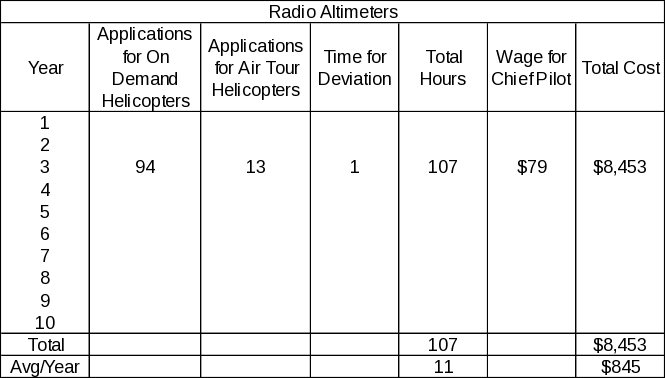
VFR ceiling and visibility requirements for class G airspace. (§135.609)
Each certificate holder may designate local flying areas (50 nautical miles in any direction from a designated location). Each certificate holder could designate more than one local flying area but no certificate holder is required to designate any local flying areas. A pilot employed by a certificate holder using local flying areas must pass an examination given by the certificate holder within the 12 calendar months prior to using the local flying area. We estimate one half of the 73 operators would designate one local flying area. A chief pilot would designate each local flying area spending 2 hours mapping and describing it for the local FAA field office. The 2 hours would apply to each local flying area. Establishing a local flying area is a one time event.

VFR flight planning (§135.615)
This section requires the pilot in command to document the highest obstacle along the planned route of flight. Changes to the planned flight that occur while the helicopter is on the ground at an intermediate stop require evaluation of the new route. VFR flight planning procedures must be added to the certificate holder’s operations manual if not already there.
Each pilot would spend 5 minutes prior to each air ambulance operation and a change would occur 5% of the time taking another 5 minutes. We estimate 367 operations per helicopter per year. 95% of the operations will take 5 minutes and 5% will take 10 minutes.
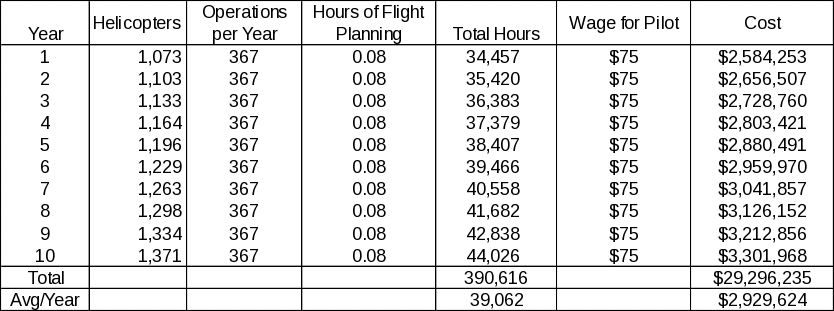
Pre-flight risk analysis (§135.617)
This section requires each certificate holder performing helicopter air ambulance operations to implement an FAA-approved pre-flight risk-analysis program documented in its existing operations manual. This section lists the areas that must be covered in the manual. The certificate holder must develop a pre-flight risk analysis worksheet that covers at least the same listed areas. The pilot in command must complete the worksheet prior to the first leg of each helicopter air ambulance operation, sign it and specify the date and time it was completed. The certificate holder must retain each completed worksheet for at least 90 days. 73 certificate holders would be affected. We estimate a chief pilot would take 30 hours to develop the program and to document it in the operations manual. A clerk would take 30 hours to edit, copy, and distribute the changes to the manual.
The pilot would perform the risk analysis taking 10 minutes per operation. We estimate 367 helicopter operations per year.
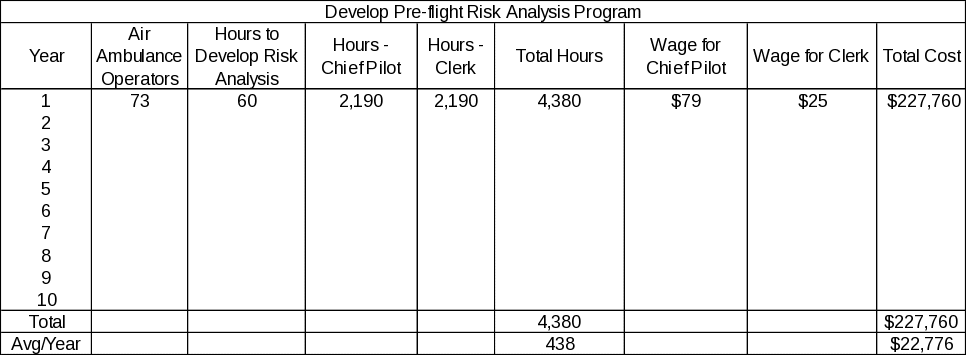
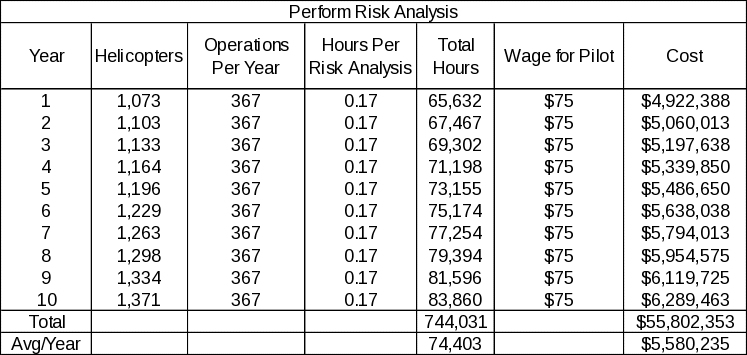
Operations control centers (135.619)
This section requires certificate holders authorized to conduct helicopter air ambulance operations, with 10 or more helicopter air ambulances, to have an operations control center staffed by operations control specialists (OCS). Those specialists would communicate with pilots, advise pilots of weather conditions, and provide flight-following services. They would also participate in the pre-flight risk analysis completed by the pilot in command (§135.617); acknowledging it and specifying the date and time it was completed, and that according to their professional judgment, the flight can be conducted safety. The certificate holder must have an FAA-approved OCS initial and recurrent (every 12 months) training program and conduct an FAA-approved knowledge and practical test. The certificate holder must retain a training record for each specialist for the duration of that individual’s employment and for 90 days thereafter. The certificate holder must document the duties and responsibilities of the OCS in their operations manual and the OCS training program in its training manual. The information would not likely already be contained in the existing manuals since this is a new position although some already voluntarily use employees with different titles but some similar duties. Compliance for this section is 2 years after the effective date of the final rule.
The OCS would take 5 minutes per operation to finish review of the pilot’s worksheet.
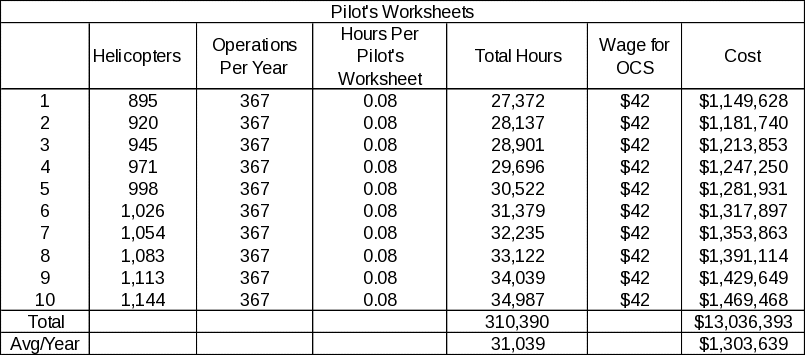
There are 15 operators with 10 or more air ambulance helicopters. Thirteen operators would need to establish an OCC. The chief pilots would take 60 hours to develop the OCS training/operations manual. The clerk would need 30 hours to edit, make copies, and distribute the revisions to the manuals. We estimate 2 operators would only need to make a small amendment to their existing manuals because they have a similar program currently in place. For these operators, the chief pilot would take 1 hour to revise the manual and the clerk would need 30 hours to edit, make copies, and distribute the revisions to the manuals.
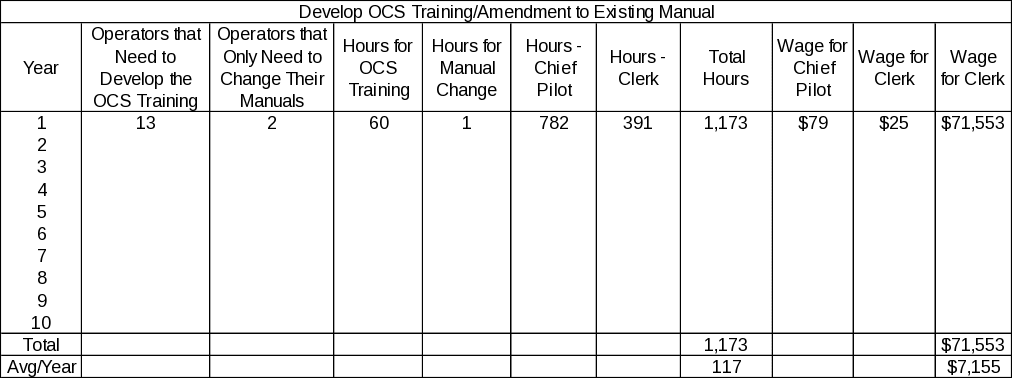
The OCS would take training every 12 months with a test at the end. A record of the training including the test must be retained. The clerk would maintain the training records of the OCS’s spending 5 minutes on each record documenting that training and the test was completed on a certain date.
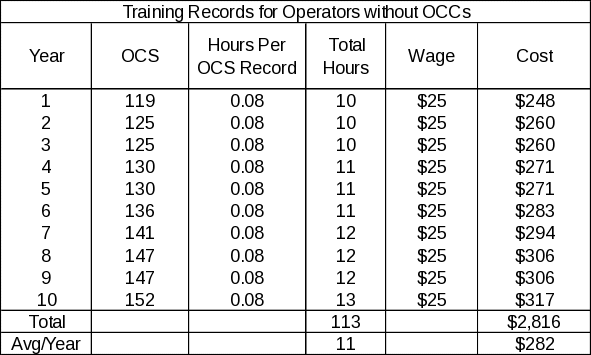
Require certificate holders with operations control centers to retain operations control specialist training records.

Training of medical personnel (§135.621)
This section indicates that medical personnel may either be trained each 24 calendar months or receive a briefing prior to each air ambulance operation. The certificate holder would retain a record of each medical personnel trained for 24 calendar months. The certificate holder conducting helicopter air ambulance operations would need to add training of medical personnel to the existing training manual. Medical personnel may or may not be employees of the certificate holder. If they are not an employee they are still trained by the certificate holder. We estimate that 50% of certificate holders will develop and conduct training and 50% will brief medical personnel prior to each operation. We estimate 10 hours by the chief pilot to develop the training and 10 hours by the clerk to edit, make copies, and distribute the training. After training is conducted, the clerk will spend 5 minutes per training record documenting the date training was completed. Development of the training is a one time event. The training records must be updated every 24 calendar months.
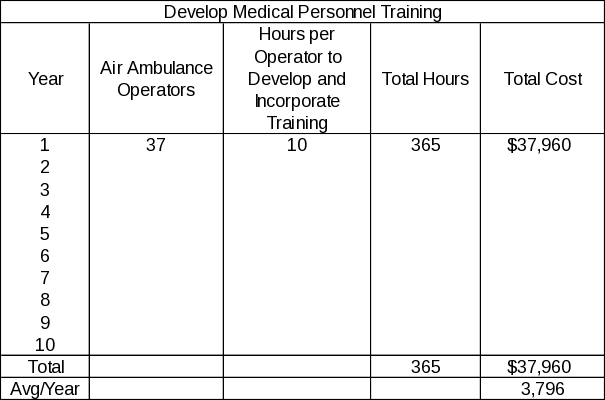
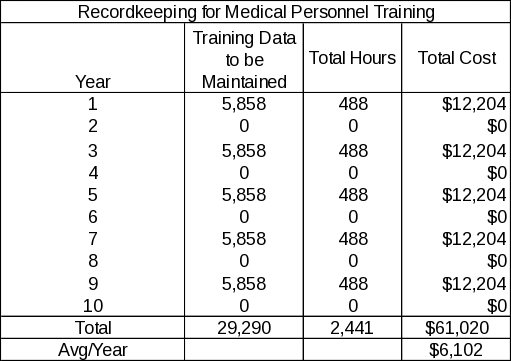
Summary of all Burden Hours and Costs
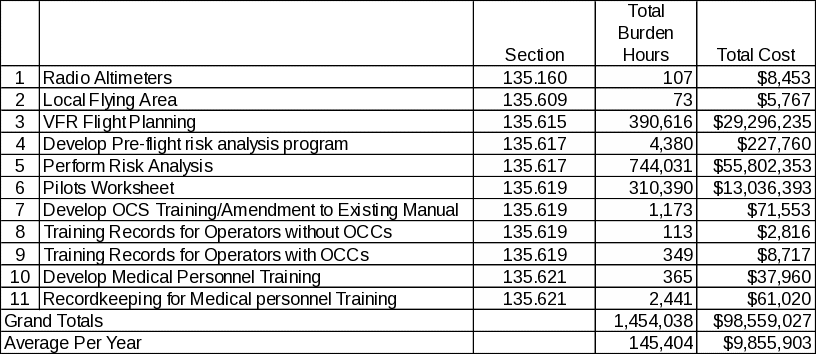
Note: The NPRM proposed to require an amendment to Recording Requirements (Load Manifests). The proposal is not adopted in the final rule. (135.63)
13. Provide an estimate of the total annual cost burden to respondents or recordkeepers resulting from the collection of information.
There are no additional costs not already included in #12 above.
14. Provide estimates of annualized cost to the Federal government. Also, provide a description of the method used to estimate cost, which should include quantification of hours, operational expenses and any other expense that would not have been incurred without this collection of information.
The provisions of the rule that will require information collection are:
The certificate holders would apply for a deviation and send the request to the FAA Headquarters. The request would be reviewed by an FAA inspector. The FAA would approve or disapprove the request. If approved, the operator’s operations specification for deviation would be generated or revised depending on if they already have some other deviation(s).
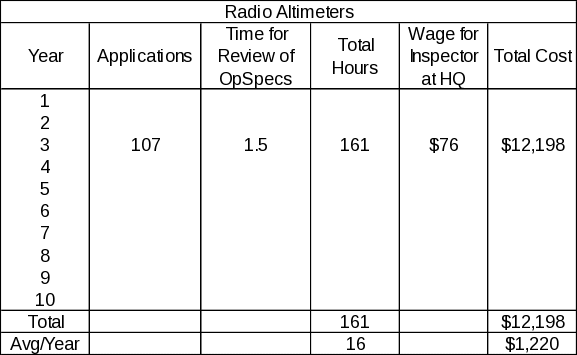
A certificate holder would designate a local flying area and send their request to the FAA field office. An FAA inspector would review and send the certificate holder approval or edits. We estimate one hour of FAA review.

Each certificate holder would develop a revision to their existing operations manual on how they will perform pre-flight risk analysis. The revision would be sent to the FAA district office for review. An FAA inspector would review.
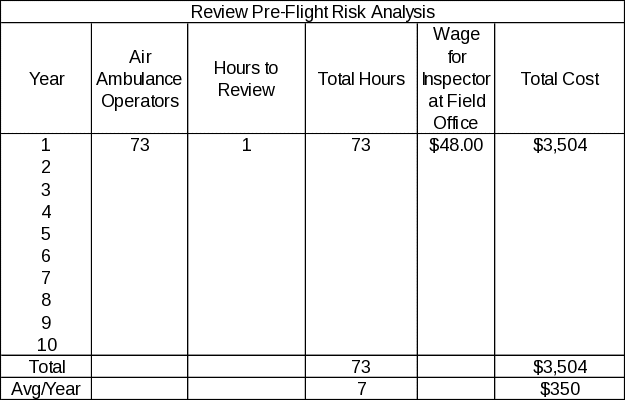
Each impacted certificate holder would develop a revision to their existing training manual and send it to the FAA field office.
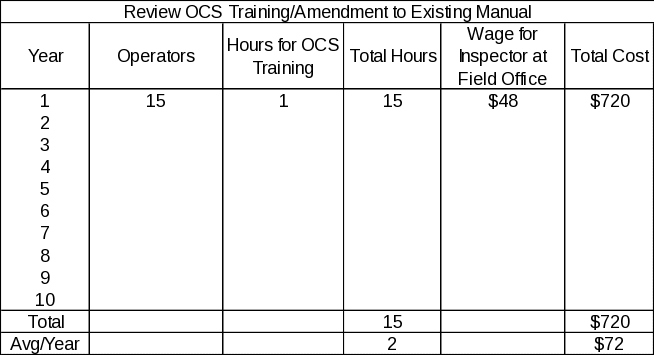
Each certificate holder would develop a revision to their existing training manual for medical personnel and submit it to the FAA field office where an inspector would review it.
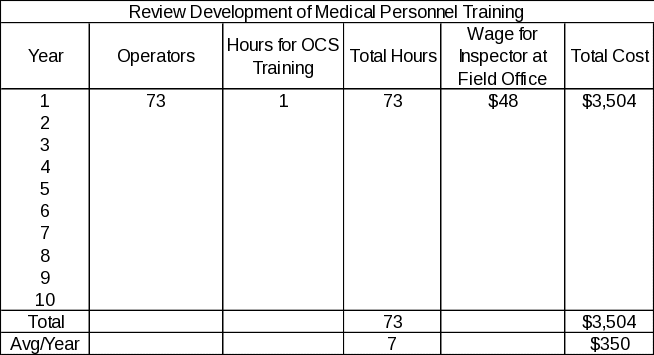
Summary of all Burden Hours and Costs

15. Explain the reasons for any program changes or adjustments reported in Items 13 or 14 of the OMB Form 83-I.
This is a new collection, therefore it is a program change.
16. For collections of information whose results will be published, outline plans for tabulation, and publication.
There is no publication plan.
17. If seeking approval to not display the expiration date for OMB approval of the information collection, explain the reasons that display would be inappropriate.
The FAA is not seeking approval to not display the expiration date.
18. Explain each exception to the certification statement identified in Item 19, “Certification for Paperwork Reduction Act Submissions,” of OMB Form 83-I.
There are no exceptions in Item 19, OMB Form 83-I.
| File Type | application/msword |
| File Title | Air Ambulance and Commercial Helicopter Operations; Safety Initiatives and Miscellaneous Amendments |
| Author | Taylor CTR Dahl |
| Last Modified By | Dahl, Taylor CTR (FAA) |
| File Modified | 2014-02-21 |
| File Created | 2014-02-21 |
© 2026 OMB.report | Privacy Policy